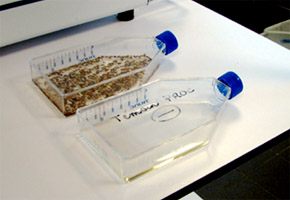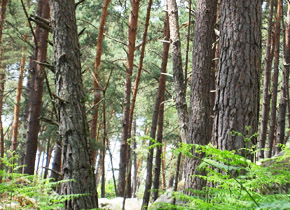M
Organisation of inter-laboratory validation tests at the European level for detecting Gibberella circinata in pine seeds
R. Ioos, C. Fourrier. ANSES Plant Health Laboratory, Mycology Unit, Nancy (France).
R. Ioos, C. Fourrier (2012). Organisation of inter-laboratory validation tests at the European level for detecting Gibberella circinata in pine seeds, EuroReference, No. 6, ER06-12M03. http://www.ansespro.fr/euroreference/numero6/PND0I0.htm
Gibberella circinata (anamorph Fusarium circinatum) is a phytopathogenic fungus causing the “pitch canker disease” in pine trees. The disease affects only the Pinus species but has also been reported on Douglas fir (Pseudotsuga menziesii). It poses a serious threat to pine forests, causing high mortality rates in the event of severe attack, and resulting at the very least in a reduction in wood growth and quality. The fungus can also infect pine seeds cryptically, and cause damping-off in the nursery. The presence of G. circinata has been officially reported by authorities in the United States, Mexico, Haiti, South Africa, Japan and Chile (Anonymous, 2005) and was recently reported in Europe, mainly in Spanish, French and Portuguese nurseries, but also in limited areas of the natural environment in Italy and Spain (Wingfield et al., 2008). G. circinata is primarily a wound parasite and enters the host through the bites of borers, pruning practices, and weather-related injuries. The fungus spreads from tree to tree by aerial dispersion of asexual propagules (micro- or macroconidia), or is carried by insects (Gordon et al., 2001). However, its long-distance spread results from the transport of infected plant material such as seeds (Storer et al., 1998). Indeed, infected Pinus seeds are most likely responsible for the introduction of the pitch canker agent in California (Gordon et al., 2001) and South Africa (Britz et al., 2001). The parasite is currently subject to emergency regulations at the European level (Anonymous, 2007) with Member States being required to implement corresponding surveillance plans. EFSA recently issued an opinion on phytosanitary risk assessment and management options for the disease. Its findings suggest that pine seeds are the most significant risk factor for the spread of the parasite (EFSA Panel on Plant Health, 2010).
There are currently several morphological and molecular methods for confirming the identity of the fungus isolated in pure culture or for detecting it directly in planta. The methods described in the EPPO PM 7/91(1) diagnostic protocol (Anonymous, 2009) include PCR-RFLP tests (Polymerase Chain Reaction - Restriction Fragment Length Polymorphism) and conventional or real-time PCR tests. Several of these protocols use some or all of the techniques developed by the Plant Health Laboratory's Mycology Unit (Ioos et al., 2009). This project's main objective was to evaluate these different protocols on pine seeds through inter-laboratory validation tests involving European reference laboratories. Ultimately, the analysis of the results is expected to provide performance values for these protocols, which will enable the European reference laboratories and plant protection organisations in the Member States to select and use the protocol that best meets their needs in terms of detection limits and relative sensitivity and specificity.
The EUPHRESCO project
EUPHRESCO is a project funded by the EU FP6 European Research Area - Network (ERA-NET) over the period 2006-2010. EUPHRESCO's aim is to improve cooperation and coordination of phytosanitary research programmes (on regulated or emerging plant pathogens and pests) at the European level through the establishment of networks of research activities and reciprocal participation in national programmes. For the specific project concerning inter-laboratory tests on Gibberella circinata, the financial mechanism selected by the partner countries was the non-competitive system, in which each research organisation in each country was responsible for its own funding.
The Plant Health Laboratory's Mycology Unit offered to organise and monitor the project with respect to: i) preparing and drafting the plan submitted to the Member States requesting the partnership agreement, ii) preparing a timetable for the project, iii) preparing the general organisation of inter-laboratory tests (defining the type and number of samples) and coordinating their implementation, iv) statistical processing of results and writing the final report.
Recruitment of participating laboratories and selection of protocols
A call for participation was issued in late 2010 via the European Mycological Network (EMN), a group of mycology units from many European reference laboratories in charge of plant health regulations. Twelve laboratories representing 11 countries ultimately expressed interest in participating in the project (Table 1).
A total of nine protocols are available in the literature (Table 2). In order to reduce costs for the participants and to increase the tests' statistical power, the first step was for the 12 partners to vote for three out of the nine protocols, justifying their choice by i) their current proficiency in the protocol, ii) ease of implementation of the protocol, or iii) the prospect of routinely using the protocol. The three protocols that won the most votes were selected for the inter-laboratory tests (Table 2). Participants were then required to choose whether to test individually, one, two or three of these protocols.
Sample size
The ISPM No. 31 standard (International Plant Protection Convention, 2008) fully addresses the issue of sampling. In the phytosanitary field, and according to this standard, statistically-based sampling requires a certain percentage of infection with a specific confidence level, and therefore that the potential "customers" of the analyses (e.g. national plant protection organisations - NPPOs) determine a priori some of the following interdependent parameters: acceptable level of contamination, level of detection, degree of confidence, detection efficacy, and size of the sample analysed. Some of these parameters are determined by the method's performance, others are the assumed choices of the "customer", which ultimately enable the most suitable size of sample for analysis to be inferred.
In addition, the most suitable sampling method must be chosen. Given the parasite's epidemiology and cryptic nature in the seeds it infects (no external visible symptoms), the distribution and rate of contamination by G. circinata in a batch of seeds is unpredictable. In this case, the simple random sampling method is most appropriate.
Another goal of the EUPHRESCO "Gibberella circinata" project was to question the different NPPOs in order to ascertain the various conceivable values for the aforementioned parameters. The Plant Health Laboratory will make a proposal for standardising these, in order to define a statistically valid sample size. Pending the feedback from this survey, a size of 400 seeds per batch, already proposed by the ISTA standard (International Seed Testing Association, 2002) was chosen for practical reasons. This size could then be reassessed at the end of the NPPO consultation process.
Sample type and preparation
In accordance with the EPPO recommendations (Anonymous, 2010) and the ISO 16140 standard (International Standardization Organization, 2003), each set of samples to be tested were to include at least three status types:
i) Batches of negative controls (seeds free of G. circinata),
ii) Batches contaminated slightly above the limit of detection (assumed to correspond to one contaminated seed in 400, at least for the mycological isolation protocol),
iii) Batches contaminated at a level corresponding to 10 times the limit of detection (i.e. 10 contaminated seeds in 400).
In addition, iv) negative specificity controls were introduced by the organiser. These seed batches were contaminated with other species of Fusarium spp., similar to Fusarium circinatum in morphological terms (to verify the protocol's specificity using morphological identification) or phylogenetic terms (to verify the protocol's specificity using molecular tests). However, to reduce costs for the participants, the number of replicates to be tested per contamination type was reduced from eight to three. Ultimately, for each protocol tested, each participant had to test four types of contamination x 3 replicates, or 12 samples of 400 seeds.
Preparation of the artificially contaminated samples was entrusted to the Italian CRA PAV Institute, one of the project partners (see Table 1). Each participant was responsible for the cost of preparing and shipping seed samples. For importing the batches of seeds artificially contaminated with G. circinata, which is a notifiable organism subject to regulations, each partner had to produce an official letter of authorisation, in accordance with Directive 2008/61/EC (Anonymous, 2008) certifying that it had biosafety facilities, trained and knowledgeable staff and appropriate working procedures.
The seeds were contaminated by soaking in calibrated solutions of Fusarium spp. microconidia produced in pure culture, followed by drying under sterile conditions to stabilise the contamination. The success of contamination (100%) was then verified by mycological isolation of seeds taken randomly from the contaminated batches.
Provisional project timetable and dissemination of results
Table 3 shows the estimated timetable for the project, which was officially launched on 1 January 2011 and should be completed in March 2012. A meeting will be scheduled in early 2012 to review progress with the partners. A summary of the project results will be published in a peer-reviewed scientific journal: this will include performance criteria for several protocols and an objective comparison of the performance of the three selected protocols, to define a statistically-based, widely accepted sample size for analysis.

References
Anonymous, 2005. Gibberella circinata. EPPO Bulletin 35, 383-6.
Anonymous, 2007. Commission Decision of 18 June 2007 on provisional emergency measures to prevent the introduction into and the spread within the Community of Gibberella circinata Nirenberg & O'Donnell (2007/433/EC). In: O.J.E.U., ed. 161. 66-9.
Anonymous, 2008. Commission Directive 2008/61/EC of 17 June 2008 establishing the conditions under which certain harmful organisms, plants, plant products and other objects listed in Annexes I to V to Council Directive 2000/29/EC may be introduced into or moved within the Community or certain protected zones thereof, for trial or scientific purposes and for work on varietal selections. In: Union OJOTE, ed. L157.
Anonymous, 2009. PM 7/91(1): Gibberella circinata. EPPO Bulletin 39, 298-309.
Anonymous, 2010. PM 7/98 (1): Specific requirements for laboratories preparing accreditation for a plant pest diagnostic activity. EPPO Bulletin 40, 5-22.
Britz H, Coutinho TA, Gordon TR, Wingfield MJ, 2001. Characterisation of the pitch canker fungus, Fusarium circinatum, from Mexico. South African Journal of Botany 67, 609-14.
Efsa Panel on Plant Health, 2010. Risk assessment of Gibberella circinata for the EU territory and identification and evaluation of risk management options. EFSA Journal 8, 1620.
Gordon TR, Storer AJ, Wood DL, 2001. The pitch canker epidemic in California. Plant Disease 85, 1128-39.
International Plant Protection Convention, 2008. ISPM N° 31. Methodologies for sampling of consignments. In. International Standards for phytosanitary measures. Rome, It.: FAO, 19. (ISPM N° 31; vol.)
International Seed Testing Association, 2002. International rules for testing. 7-009: Detection of Fusarium moniliforme var. subglutinans Wollenw. & Reinke on Pinus taeda and P. elliotii (Pine) In. Basseldorf, Switzerland.
International Standardization Organization, 2003. ISO 16140:2003 Microbiology of food and animal feeding stuffs - Protocol for the validation of alternative methods. In. Geneva, Switzerland.
Ioos R, Fourrier C, Iancu G, Gordon TR, 2009. Sensitive Detection of Fusarium circinatum in Pine Seed by Combining an Enrichment Procedure with a Real-Time Polymerase Chain Reaction Using Dual-Labeled Probe Chemistry. Phytopathology 99, 582-90.
Ramsfield TD, Dobbie K, Dick MA, Ball RD, 2008. Polymerase chain reaction-based detection of Fusarium circinatum, the causal agent of pitch canker disease. Molecular Ecology Resources 8, 1270-3.
Schweigkofler W, O'donnell K, Garbelotto M, 2004. Detection and quantification of airborne conidia of Fusarium circinatum, the causal agent of pine pitch canker, from two California sites by using a real-time PCR approach combined with a simple spore trapping method. Applied And Environmental Microbiology 70, 3512-20.
Steenkamp ET, Wingfield BD, Coutinho TA, Wingfield MJ, Marasas WFO, 1999. Differentiation of Fusarium subglutinans f. sp. pini by Histone Gene Sequence Data. Applied And Environmental Microbiology 65, 3401-6.
Storer, Gordon, Clark, 1998. Association of the pitch canker fungus, Fusarium subglutinans f.sp. pini, with Monterey pine seeds and seedlings in California. Plant Pathology 47, 649-56.
Wingfield MJ, Hammerbacher A, Ganley RJ, et al., 2008. Pitch canker caused by Fusarium circinatum - a growing threat to pine plantations and forests worldwide. Australasian Plant Pathology 37, 319-34.

Methods
Gibberella circinata is a parasitic fungus of pine trees that has been subject to European emergency phytosanitary measures since 2007. This fungus is spread over long distances primarily via pine seeds, consequently reliable detection tools and methods are required to protect the health of seed batches imported and marketed in Europe. The Plant Health Laboratory is now leading a European EUPHRESCO project aiming at the selection and the validation of one or more protocols targeting this parasite via inter-laboratories tests, as well as a suitable sampling method. The project will provide Member States, reference laboratories and industry stakeholders with one or more widely accepted, validated protocols whose level of performance has been determined through international collaboration.
Table 3: Provisional timetable for the EUPHRESCO “Gibberella circinata” project
Table 2: List of available protocols for the detection of Gibberella circinata in pine seeds. The protocols in bold were finally selected after a vote by the project partners.
Table 1: List of partners involved in the “Gibberella circinata” project
Pine seeds and negative control undergoing biological enrichment
Organisation of inter-laboratory validation tests at the European level for detecting Gibberella circinata in pine seeds






